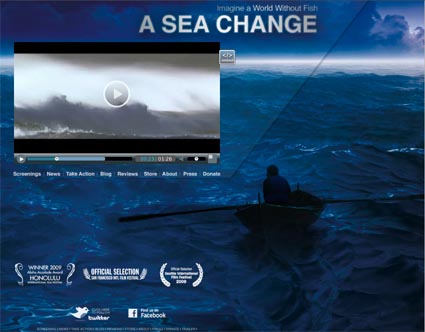A Sea Change – Tonight at 8pm

Sat., Sept. 26, 2009, 8 pm, Planet Green Network airs A Sea Change.
A Sea Change documents an extremely pressing issue, acidification of the world’s oceans. It’s an often overlooked aspect of climate change. Essentially, it’s getting harder and harder for marine life to form shells because the oceans are rapidly becoming more acidic. The point of no return is projected by scientists to be less than 50 years away.
Look for Planet Green content on cable, Direct TV, and more. It’s the first & only 24-hour eco-lifestyle TV network. A Sea Change airs as part of Planet Green’s “Reel Impact” series. They’re in terrific company: also airing are An Inconvenient Truth, Who Killed the Electric Car, and No-Impact Man.
Tell your friends. Email your representatives. The oceans aren’t on the table at the upcoming summit COP-15. That needs to change.
Find out more about this issue at worldchanging.com.
Ramya Reddy Exhibits at Apparao Gallery

Ramya Reddy exhibits her first solo exhibit at Apparao in Chennai, India.
Timeless Solitude is on display from September 16 – 30.
The exhibit moves on to Bangalore.
Stay tuned for details.
Find out about Apparao Gallery.
Find out about Ramya Reddy.
Alumni Success Stories

This space is for you!
If you’re an alumn of my workshops/seminars …
I want to hear your success stories!
And I want to share them with the world!
Got a new book?
Featured in a magazine?
Won a contest?
Have a new exhibit?
Landed a new assignment?
Print made it in a prestigious collection?
Experienced a great travel adventure?
Took a great workshop?
Used great tools?
Learned something valuable?
Tell us about your discoveries here!
How do you submit material?
Send me your ready to post text as an RTF file.
Include full urls for relevant links …
i.e. http://www.johnpaulcaponigro.com/workshops.
Include at least one image – 425 pixels wide, sRGB, 8 bit, JPEG setting 6-9.
Email me at johnpaulcaponigro@hotmail.com.
That’s it!
I’ll post it!
Facebook – John Paul Caponigro's Alumni

Want to connect with other alumni on Facebook?
Join John Paul Caponigro’s Alumni Facebook Group today.
Share your stories, get feedback, learn, make new friends.
Flickr – John Paul Caponigro Alumni

Share your images and feedback with other alumni.
Join John Paul Caponigro’s Alumni Group on Flickr.
When you post your images they’ll be shared in the image cloud above.
Twitter – Creativity Quotes

Get inspiring creativity quotes.
Follow me on Twitter.
You can even sign up there for the RSS feed and read them in your Google Reader.





